




























As sad as I am to see the final swallows depart our shores for their wintering grounds, there is always something very special about the changing seasons. I’ve always found migration such an incredible concept, and I’m completely in awe of the journey that millions of birds make; particularly those youngsters, not long out of the nest, who are travelling for the first time out of pure genetic instinct.
The fact that our adult swifts won’t land again for around 10 months is mind-boggling to many of us. But it’s the perfect example of just how remarkable the natural world is, and how we must collectively fight to protect our extraordinary natural heritage.
Is it really too much to ask housing developers to add swift bricks in every new home? Is human greed so out of control that we can’t even make a gesture to meet nature halfway? Unfortunately, the reality is that we need way more than just environmental symbolism; we need a shift in behaviour which places the sustainability of the planet at the heart of everything that we do. Denial is a detour that leads us nowhere. We are all accountable for our actions and we can therefore all play our part.
Autumn leaves for solitary bees
Dr. Andrew Impey Chief Executive OfficerEditor-in-Chief Emily Buttress
Trust.
We are the county’s leading conservation charity, committed to protecting wildlife and inspiring a lifelong love of nature.
We manage nature reserves and discovery parks across the county, providing outstanding outdoor learning and preserving places of wonder.
Founded in 1959 by volunteers, we protect over 100 sites across Essex and are supported by 40,000 members.
Our climate is in crisis and nature needs our help. Together we can protect the future. Join us.
We are one of the largest Trusts that work together throughout the British Isles as The Wildlife Trusts.

Executive Editor Rich Yates
Editors Bailey Tait and Lauren Cosson
Editorial Assistants Charlotte Mugliston and Francesca Chantry
Art Director Lottie Hall
Designer Tasha Mound
Advertising Jamie Watt
To advertise in WILD magazine contact Jamie on JamieW2@essexwt.org.uk
Printing The DS Group
WILD magazine includes adverts from third-parties. However, services offered by advertisers are not specifically endorsed by Essex Wildlife Trust. The income from advertisements goes towards the cost of printing and postage. This means that more of your membership donation goes directly towards conservation. Adverts must conform to the British Code of Advertising Practice.
Copyright © Essex Wildlife Trust 2023
Let your fallen leaves lie to give solitary bees a nesting site and shelter from colder winds and rain. You could even create a leaf and twig pile, or a bee hotel www.essexwt.org.uk/actions
Check your bonfires
Hedgehogs, toads, frogs and other animals might try and claim your bonfire as a hibernating spot. Search ‘How to: Check your Bonfires for Wildlife’ at www.youtube.com/essexwildlife
Tell your friends
Your family and friends can keep up to date with the Trust by signing up to receive monthly Wild News straight to their inbox at www.essexwt.org.uk/wild-news
Adopt
We really hope you enjoy receiving your magazine. If, however, you would prefer to convert to our digital-only Green Membership, please contact the Membership Office on 01621 862964 or by email at members@essexwt.org.uk. We will be delighted to help you manage how we communicate with you.
‘We are all accountable for our actions and we can therefore all play our part.’
We’re celebrating our incredible nursery, two years after we opened the doors to the conservationists of the future.
Page 16

We’ve picked our favourite photos of yours to showcase, from across Essex.
Updates from throughout the Trust on our work to protect wildlife and inspire a lifelong love of nature.
There has been a lot of change in the world since 2020, we have updated our Strategic Plan to focus on creating the most impact during these crucial years for nature.
We take a look at some of the magnificent birds crossing continents and seas each year.
Autumnal colours are on their way and there’s plenty of spectacles to enjoy and events to join in with before hibernation begins.
We take a closer look at the spectacular ‘sea hares’ adding a splash of colour to UK rockpools.
Updates from The Wildlife Trusts movement on national projects and campaigns for wildlife.

We travel back in time to the year 1983 to see what was happening at the Trust.
In the Coronation year, we’re honouring our Coronation Meadows, while looking at how we can increase the coverage of wildflowers in our county.

The only place in Essex where all three species of heather can be found growing together, this reserve has a fascinating history.
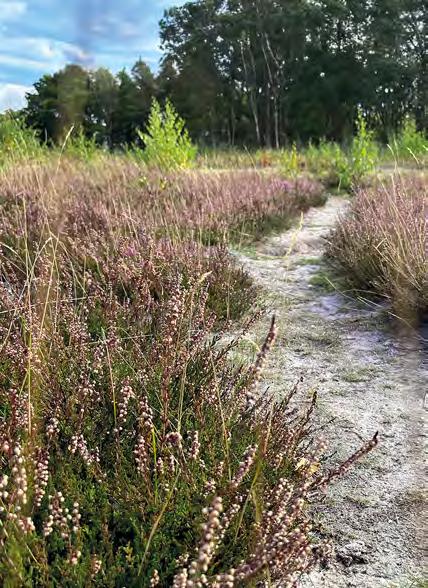
Nature Neighbours is back and this year it’s all about one of our garden’s best friends, the warty, wide-eyed and wonderful toad.
 Toad: Tom Marshall
Green-winged orchid: Lianne de Mello
Toad: Tom Marshall
Green-winged orchid: Lianne de Mello
Summer brings with it singing birds, vibrant wildflowers and beautiful butterfly sightings. Our members and supporters have made the most of the longer days and captured the wildlife spectaculars! Feast your eyes on our selection of wildlife snaps submitted by you over the past few months.


If you would like to feature in our next edition of WILD, please email your favourite images of Essex’s wildlife and wild places to magazine@essexwt.org.uk or tag Essex Wildlife Trust on social media.
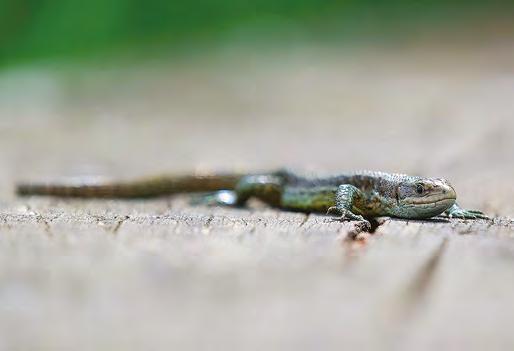

stay very still,


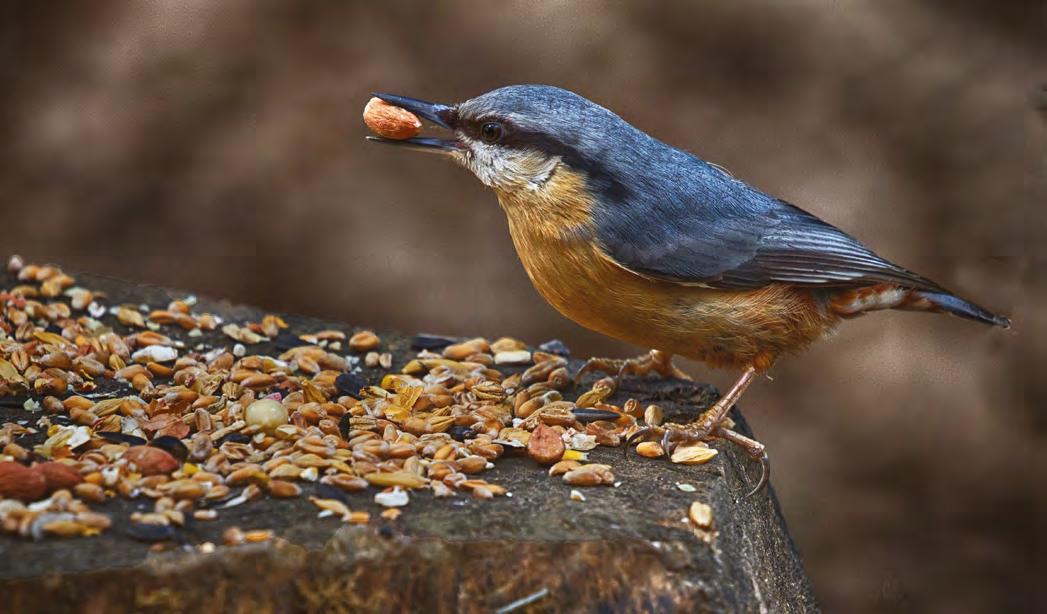

see me’,
perfectly
Stories and news from throughout the Trust on our work to protect wildlife and inspire a lifelong love of nature across Essex. Written by our staff, volunteers and members of our Local Groups.
Charli
McLachlan GIS and Data ManagerWe are using remote sensing on some of our reserves to supplement on-the-ground surveys and provide us with detailed habitat information.

At Willow Park, Langdon, we recently had a drone survey carried out to help assess habitat opportunities for invertebrates. By collecting several types of imagery, providing information about temperature, structure, elevation and vegetation type, we plan to quantify the variation in microhabitats present.

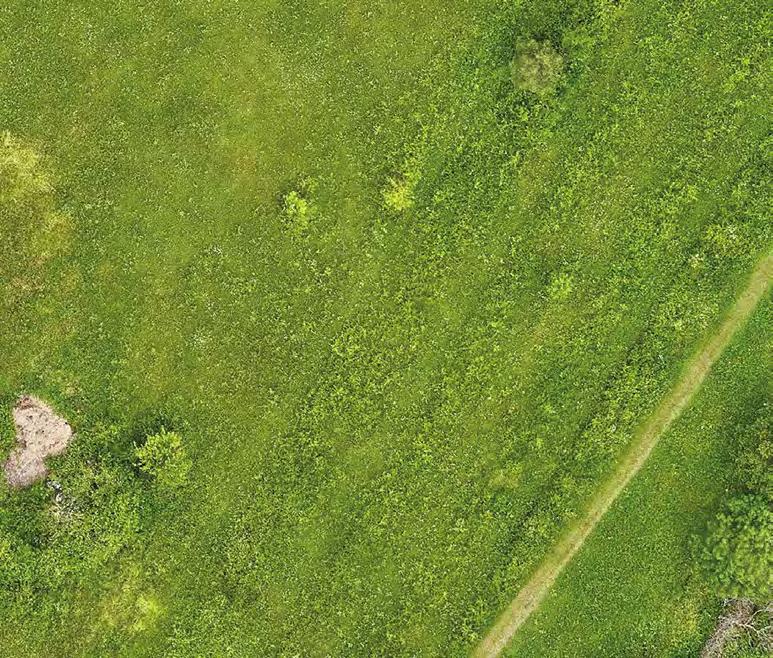
The more varied structure and microhabitats available, the better potential for a range of invertebrates to thrive.

We will also compare the results of our analysis with on-the-ground surveys for the same areas. We hope that these surveys will offer more detailed information in less time, and with less disturbance to habitats compared to walking transects across large areas.
Our surveys are undertaken by a qualified and licensed operator using appropriate timing and methodology to minimise disturbance to wildlife. Relevant consents are sought in advance.
In June, we launched a brand-new citizen science campaign to help us understand more about butterflies in Essex. We asked everyone to download the ArcGIS Survey123 app and record their butterfly sightings through the Butterfly Seekers survey.

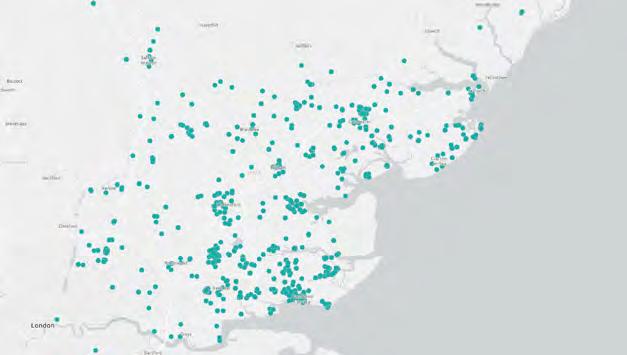
We set out to collect 2,000 records between 5 June – 30 September But thanks to our supporter’s passion and determination, we reached that target within just one month! The data collected tells us when different species of butterfly emerged as well as distribution and abundance of butterflies within our county. From year one of the campaign, our Conservation Evidence Team will be able to use this information to help inform conservation efforts. By building on this data each year, we can monitor trends over time and help butterflies to not just recover but thrive again.

 Lauren Cosson Communications Officer
Lauren Cosson Communications Officer
In June, we received this lovely letter from 7-year-old Quinn. Quinn and her siblings, Josie and Cooper, took part in this year’s 30 Days Wild challenge and have carried out many fantastic Random Acts of Wildness. Not only that, but it was great to hear about their wildlife-friendly activities throughout the year, including litter picking and wildflower planting. We love to hear from people taking part in our campaigns, or taking action for wildlife, so send your photos and stories to magazine@essexwt.org.uk

 Zoe Ringwood Head of Conservation Evidence
Zoe Ringwood Head of Conservation Evidence
In the UK, there are 57 species of wild orchid. Some of these species rely on specific conditions to grow and are limited to rare habitats. In Essex, the Trust manages some very important sites for vulnerable and near-threatened orchids. At Chafford Gorges Nature Discovery Park, we have the largest population of man orchids, alongside numerous other species including pyramidal orchids, bird’s nest orchids and common spotted orchids. Thanks to ecological monitoring, we have surveyed our reserves for numbers of these wildflowers. We are pleased to share that Oxley Meadow had the highest count of green-winged orchids, a near-threatened species, since 2017. Due to the specific soil components, more specifically the presence of mycorrhizal fungi, green-winged orchids are able to seed and germinate here. Please note that orchids are vulnerable wildflowers and it is important to stay to marked paths to preserve them.
Gemma Cosson Campaigns Assistant
Essex boasts a 350-mile-long coastline and is home to fascinating marine life such as cuttlefish, stingrays, sharks, nudibranchs and more. From 22 July – 6 August, we celebrated our marine life in Essex and around the UK.

Through live-streamed videos, we learnt about the important habitats and species Essex Wildlife Trust’s projects protect and restore. Our Marine Team talked us through carbon-capturing saltmarsh and seagrass habitats, the significant environmental role of oysters and the impact of plastic pollution on our marine life. Thank you to those who tuned in and asked our team questions. If you missed us, you can watch the recordings back by searching for ‘Marine in the Moment’ on www.youtube.com/essexwildlife
Adam Nixon Coastal Ranger
Thank you to the 145 people who entered the Coastal Creations Art Competition! Congratulations to the category winners and runners up who will have their artwork displayed at The Naze Nature Discovery Centre.

Although National Marine Week has come and gone, there is never a bad time to explore Essex’s glorious marine life. Spending time at the coast has also been linked to improved mental health and wellbeing, so why not explore the coast this weekend?
The season was successful with oystercatcher and ringed plover nests found across Colne Point, Tollesbury Wick and Old Hall Marshes nature reserves, as well as on Mersea Island. Although little terns were not successful in the Blackwater and Colne estuaries, they had a very encouraging season in Hamford Water. We had a number of disturbances on the sites, mainly from people on jet skis; the Essex Police Marine Unit were informed and have taken action. The recruitment of a new Coastal Ranger to coordinate the project also meant a greater presence across Essex Wildlife Trust reserves over the key summer period.
The team engaged with local communities and young people to help shine a light on our beach-nesting birds and how people can help to protect them. This included the Essex Food and Farming schools’ day at Writtle College and Clacton-On-Sea’s Pride. This complements the engagement work of Bird Aware Essex along the coast.
Thank you to everyone who has supported this jointly-led RSPB and Essex Wildlife Trust project, and spread the word about our amazing beach-nesting birds. As we head into the autumn and winter months, we are reviewing the season, including research from the University of Essex, and beginning preparations for next year.
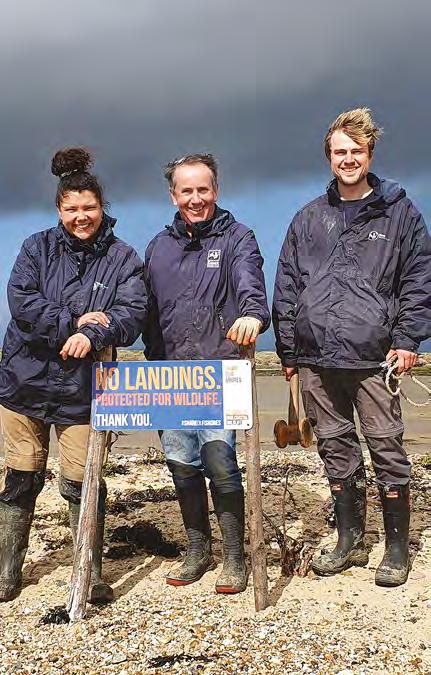
This year, an outreach programme with local primary school children has taken place at Brightlingsea Harbour, the site of a native oyster nursery. Native oysters have declined by 95% and are threatened by overharvesting, pollution, habitat loss and competition with non-native species.


The Trust taught the Year 5 students about the importance of native oysters for wildlife, threats to their population, and their historical importance in the coastal community.

Students also helped to conduct in-person surveys of the native oyster population that the Trust continues to monitor, by identifying mortality rates of oysters and any additional species in their nursery cages. Sightings included shore crabs, common prawn, common blenny, sea spider and sea gooseberry.


Virginia
WalshBusiness Partner – Culture
This year, we attended London, Clacton & Colchester Pride events and have been inspired to meet LGBTQ+ people and nature enthusiasts across Essex. Any person who identifies as LGBTQ+ will always be welcome at the Trust because wildlife is for everyone. Scan the QR code to read our blog outlining our commitments to the LGBTQ+ community.

A book including contributions about the popular coastal nature reserve, Colne Point, has been published in line with the reserve warden’s retirement. With 98 contributions, this 210-page book is an exploration of Colne Point, featuring the history, industry, recreation, people and its diverse wildlife. With illustrations and photographs, eyewitness accounts, and input from historians, artists and poets, the book is a must-read for anyone wanting to know more about this nature reserve and its history. Originally intended as recognition of Bob Seago’s retirement, warden at Colne Point for 22 years, the book grew into a much larger project than first envisaged.
Edited by David Bain, Honorary Secretary ofTendring
Local Group,and Kevin Marsden, Chair of Tendring Local
Group.The book is available to purchase for £20 from Essex Wildlife Trust Nature Discovery Centres, or you can email david.r.bain@gmail.com
Our plant sale in May at Langdon Nature Discovery Park was very successful and raised some good funds for Trust causes. We are grateful to all those local members who donated plants and shrubs and to those who helped out with this event. A special thanks to the main organiser, John Allen, and to all the staff at Langdon.
We try to make our programme of events attractive to Trust members living in the Billericay area. So, in October, members may like to note an illustrated talk on Norsey Wood as well as a fungi foray in this ancient woodland. More details about these events as well as the rest of our autumn programme are available on the Trust website and on Facebook where you can find us at @EWTBrentBillLG


David Bain Secretary
April was a busy month for our group, with the annual Barnes Spinney plant sale and Bluebell Day at Weeleyhall Wood, that were well supported. At the major fundraising events, we are now better equipped with two card-readers. Pond-dipping at the Great Holland Pits Open Day on 28 May attracted good numbers. In contrast, Cockaynes Activity Day on a very hot day in June was unfortunately less well supported. Our summer programme continued with an Open Day at Wrabness nature reserve, now famed for its turtle doves, in July. On 18 October, RSPB’s Mark Nowers is speaking at Beaumont village hall on the recovery programme for these special birds. The beach walk and litter pick at Colne Point on 23 September is a follow-up to our recent book on this fine reserve that is selling well.
For more local updates, follow us on Facebook @EWTTendringLG
Braintree Local Group has an exciting programme of illustrated talks running through 2023. In February, we enjoyed a fascinating talk about peatlands from Richard Lindsay. In March, Stephen Clarkson from the Wild Flower Society took us on ‘A Whistle-Stop Tour Through our Wild Flowers’. In April, we heard all about bumblebees from John Taylor from the Bumblebee Conservation Trust. In May, Matt Moran told us all about foxes. These talks were highly informative and enjoyable and accompanied by wonderful photographs. Please join us for our upcoming talks on glow worms in September, reptiles of Essex in October and ‘An Unnatural History of Rivers’ in November. The talks take place on the third Tuesday of the month at St Andrew’s Church Hall in Halstead, starting at 7.30pm. Full details are available on the Trust’s website www.essexwt.org.uk/events
Diane Cattermole Chair
Colchester Local Group was pleased to assist Essex Wildlife Trust staff when we attended two stands in different venues to promote both the Nature Nursery and the Local Groups’ activities.
In June, Perrywood Garden Centre in Tiptree welcomed us for the day. We were able to speak to many of Perrywood’s customers, some of whom had children with them. We showcased the Nature Nursery and the Trust and gave out magazines and games to the children. There was a play area and Billie Badger was there to entertain the kids.
The following week we shared a stand with Rosie Abbott, Business Partner – Volunteering, at an event in Colchester Castle, in an initiative hosted by One Colchester for Volunteers’ Week. Again, we were able to promote the activities of the Local Group along with chatting to other local volunteer organisations.


MINIBEASTS team work
POND DIPPING
Bushcraft Geography Topics plus lots MORE!
We offer a range of educational visits across the county, showcasing habitats from woodland, grassland to saltmarsh and coastal habitats. Our schools programme brings learning to life. Gain knowledge and skills through curriculum-linked or enrichment opportunities at a Nature Discovery Centre or on your site. Suitable for all ages and abilities. School visits are led by experienced Wilder Learning Officers.
For more information scan the QR code or email us at
learnoutdoors@essexwt.org.uk
A lot has happened since we launched our last organisational strategy at the start of 2020.
Within weeks, the country was plunged into the chaos of Covid. Successive lockdowns altered the trajectory of the decade that lay ahead — and not always for the worst. The importance of the natural world was given a spotlight, at least for a period, and our dependency on nature was revealed in all sorts of ways.
We are no longer riding the wave of heightened national nature connection, but we are without doubt operating in a new world that requires a revised strategy.
As members of the Trust, we would love for you to get behind the new Strategic Plan 2030, which, more so than ever before, focuses on how we can help restore nature beyond our own landholdings and how we can encourage people to act on its behalf.
The time to act is now. As hard as it may be to contemplate, we are in the midst of a combined climate and ecological emergency. We are rapidly approaching a tipping point: we either start to deliver nature’s recovery or we cross a line from which we may never be able to come back.
Although the stakes have never been higher, the necessary resources and regulatory framework to tackle the drivers of change have not been forthcoming from successive governments in recent years. The onus is therefore on all of us.
There has never been a more important time for Essex to have a Wildlife Trust that delivers high impact. Our county is one of the most over-developed in the UK, a country which is, according to the Biodiversity Intactness Index, one of the most nature depleted countries on Earth. It may not always feel like it, but we are at the epicentre of the nature crisis.
In terms of direct conservation, our aim is for ‘30% of land and sea in Essex to be actively managed for nature’s recovery by 2030’. We call this aim ‘30 by 30’ for short.
There are two principal ways in which we will deliver 30 by 30. The first is by ‘Leading wildlife gain across the county’ (Objective 1.1). We need to be the driving force for nature’s recovery in Essex, working in partnership to achieve the best possible gain for wildlife.
The second is by ‘Enhancing the conservation value of our land’ (Objective 1.2). We need to lead by example and establish our sites as exemplar reserves, demonstrating excellence in conservation.
In terms of indirect conservation, our aim is for ‘1 in 4 people in Essex to take action for nature and climate by 2030’. We call this aim ‘1 in 4’. This is the tipping point when minority views and behaviours enter the mainstream and change social norms: ergo, if we can get 25% of people acting for the natural world, the rest will eventually follow.
As with Aim 1, there are two ways that we will deliver 1 in 4. The first is by ‘Creating places of wonder’ (Objective 2.1). We are fortunate to have several Nature Discovery Centres across the county, as well as our nature reserves. These centres will provide a gateway to great wildlife experiences, widen access to the natural world, and inspire people to take action.
The second is by ‘Bringing people and wildlife closer together’ (Objective 2.2). We need to provide all people in Essex with opportunities to engage with wildlife at every age and stage of life, positioning ourselves at the forefront of outdoor education and community engagement in all its forms, as well as campaigning and lobbying.
Our third aim is to be ‘A thriving organisation delivering high performance and high impact’, which we intend to do in two main ways: by ‘Working together for wildlife’ (Objective 3.1), which sets the standards of culture and performance by which we will succeed, and by ‘Making the best use of our resources’ (Objective 3.2), which will focus us on making sure we have the right resources deployed in the right way at the right time.
We hope that the new Strategic Plan 2030 also offers a helpful framework for you to think about how we can tackle the nature crisis. As a roadmap for the county, it should be a source of hope.
We would dearly love you to be involved in whatever way you can, from the smallest action, such as reporting a toad sighting, to prioritising the welfare of wildlife on the land you might own, to starting a community group in your village or town. Please do get in touch or search the website for ways that you can get involved.
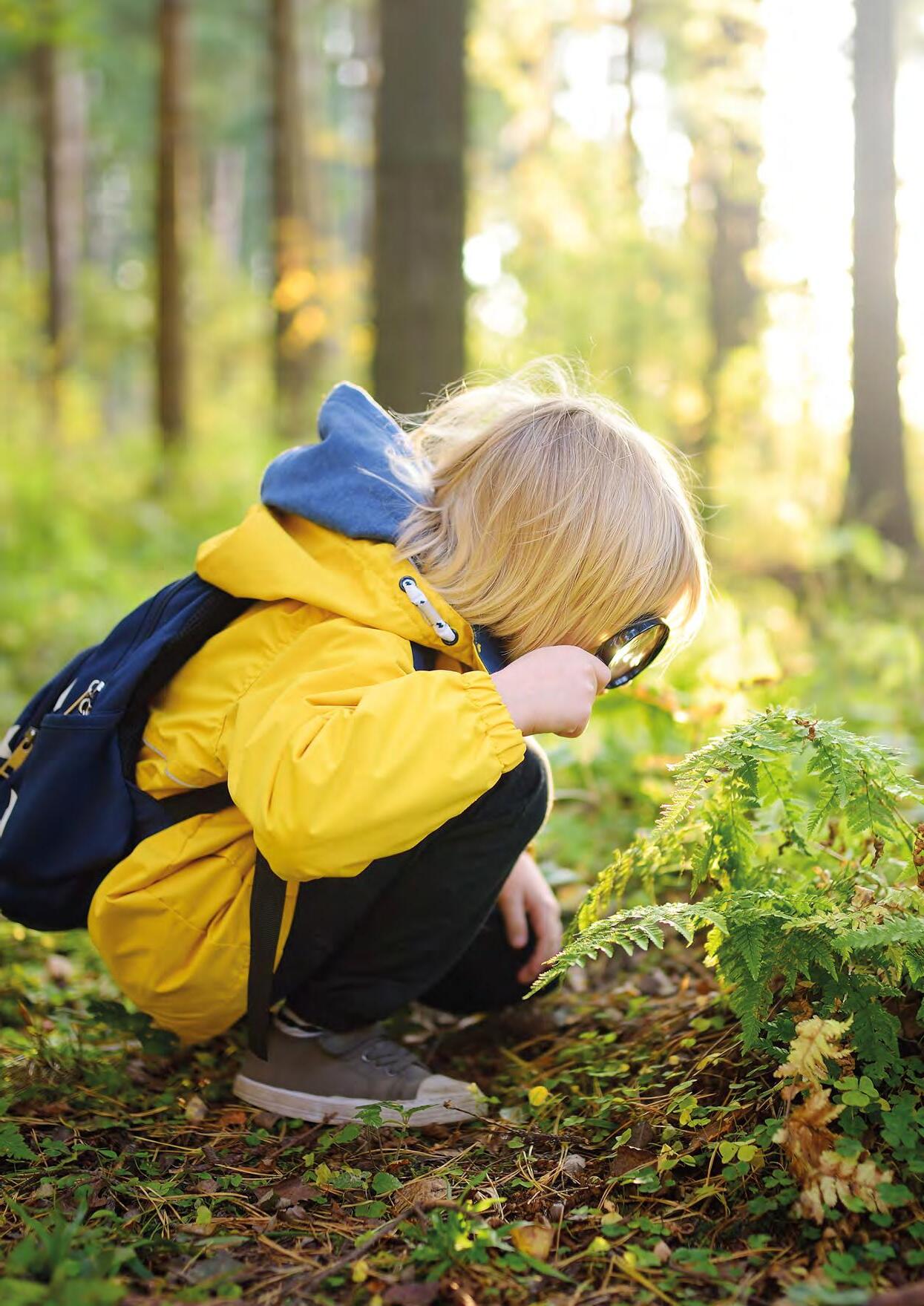
In October 2021, we opened the doors to our first outdoor Nature Nursery with the aims of delivering outstanding educational childcare, while inspiring a lifelong love of nature in children.

Since then, we have seen 67 children join the Nature Nursery, with 17 having ‘graduated’ this summer. The grounds have been transformed, with children and their parents helping us to plant trees and vegetables around the site, and our Mongolian yurt, hammocks and outdoor shelters are now all nestled into the meadow.
In May this year, we had our first Ofsted visit, with the Nature Nursery awarded 'Outstanding’, describing it as “idyllic”, and we couldn’t be prouder.
At Essex Wildlife Trust, we have led Forest School sessions for children since 2008 and have delivered Forest School training since 2014, training over 250 practitioners and encouraging schools across Essex to offer outdoor sessions in their curriculum. The next step in our ambition to connect children of all ages to the benefits of the natural world was to launch our first nursery, following the Scandinavian approach of taking learning outdoors.
The nursery follows the same statutory Early Years curriculum, but almost all learning takes place outdoors, and we enrich the curriculum with our natural environment. No two days are the same and as the seasons change this makes for a dynamic learning environment. Children learn through child-led, nature-based exploration and activities led by Early Years professionals who are passionate about the natural world. Here, children learn to determine how the weather changes, they talk about different cloud types and what that might bring. Our wonderful team say to our families “there’s no such thing as bad weather, just bad clothing” and the children embrace the outdoor environment all through the year.
It’s difficult to compare the Nature Nursery to a ‘traditional’ nursery. The nursery sits within our 282 hectare nature reserve at Abbotts Hall, giving it a background of meadows and woodland that are ventured into often. This large space allows children to be curious and we’ve set up a fantastic enabling environment, created by staff, children and their parents. Our children have the freedom and autonomy to plan their days. They can dig, investigate, create and explore the living world around them.
Sustainability is also at the heart of the nursery, helping young children become resilient individuals for the future. The children plant seeds with their parents and we like to encourage our children to know where their food comes from. At the same time, they develop a real love of nature as they nurture their seedlings. The children know how to distinguish different plants, and they take part in cooking activities with the homegrown ingredients using our pizza oven and creating soups and stews in the winter.
The magic of the Nature Nursery was confirmed when Ofsted awarded it 'Outstanding' this spring. Our staff were praised for their safeguarding, care and communication with the children. The setting was deemed “idyllic”, and our highlight was that the report recognised children “are becoming considerate citizens who care for their world”.



This is an especially important highlight for Essex Wildlife Trust. Mel Mewton, Outdoor Nursery Manager notes how recognisable this is with our children: “The beauty of the nursery is that children care. They see invertebrates in the woods, and they carefully put logs back down to keep their habitats safe. They know the difference between a centipede and a millipede from the ages of two to five and they can distinguish the difference between blue tit and great tit bird songs.”
Mel notes that the nursery site is “like Heathrow for birds”. This allows children to “often laze in the hammocks or on the grass, watching all the birds pass by.” The Ofsted report also made notable comments on how “ambitious” our curriculum is and stated “children make exceptional progress in their learning”, with both mathematics and vocabulary development praised.

It was highlighted how curiosity and independence is cultivated at the Nature Nursery and praised our team that run it. The Nature Nursery was also awarded the Millie’s Mark in October 2022, an endorsement that recognises childcare providers are trained in paediatric first aid.
Mel Mewton continues, “We are so proud of the Nature Nursery and recent Ofsted rating. The aim of our nursery is to help secure a healthier, happier, and more sustainable future. A future where every child is ‘wild’ is a future where the planet is in good hands. Seeing children care about the environment and developing into independent, creative people is a wonderful thing to be a part of.”
If you would like your children to experience the magic of learning and growing at the Nature Nursery, our team run regular Open Days for prospective families. Visit www.essexwt.org.uk/nature-nursery for more information.














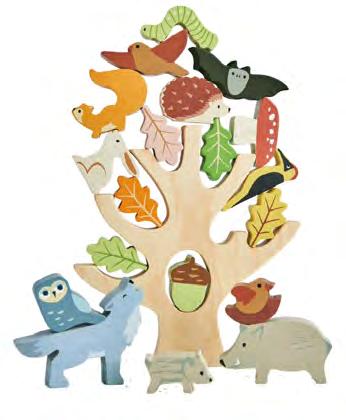








First recorded in the 15th century, this heathland once stretched from Colchester to Maldon over 600 years ago. Now, the nature reserve is just one piece of that historic landscape, designated a Site of Special Scientific Interest (SSSI) for its contribution to wildlife. Home to rare and unusual species, this natural wonder is the largest surviving lowland heath in Essex.


With purple and lilac colourations, this site boasts all three types of the UK’s heather species. Blooms for this shrub start at the end of the summer and peak in early autumn.
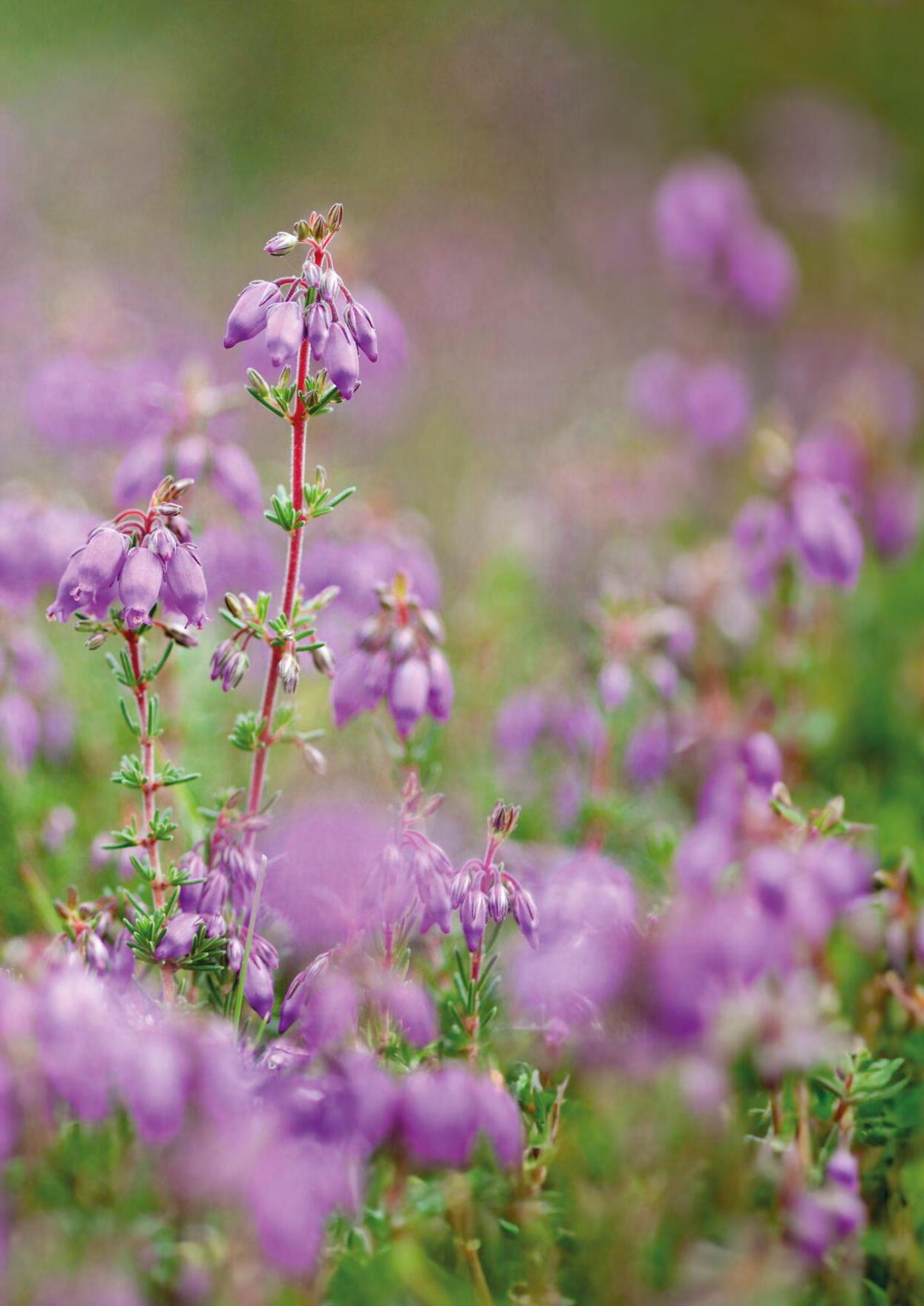
Listen to the echoes of the great spotted woodpecker drumming loudly at the trees in the woodlands nearby. As green woodpeckers hardly drum, listen for their ‘yaffle’ – a laugh-like call used to communicate.
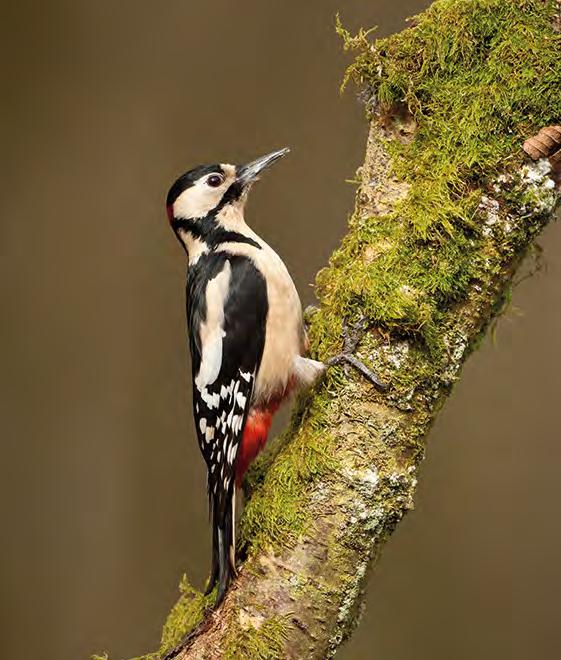

These birds make great predators, often ambushing their prey from a perch or flying low to the ground. Look for rounded wings and striped underbellies and chests.
Found on sandy grassland and heathland, these large jet-black beetles are named for their three bull-like horns sported only by the males. Adults start to emerge in autumn, hungry for food.

Size: 24 hectares.
Address: 204 Maldon Road, Tiptree, Colchester, CO5 0PT
Access: Large car park at entrance to the reserve. Paths are unsurfaced but mainly flat. Grazing cattle from March – October.
Dogs: Under effective control. Please keep dogs on leads near livestock.
Before the roads that are now used to travel from Maldon to Colchester and back again were established, Tiptree looked very different. Over 600 years ago, it would have been possible to walk that journey entirely on heathland. Now, Tiptree Heath is the last remaining part of that landscape and is managed jointly by Essex Wildlife Trust and Friends of Tiptree Heath.
Situated along Maldon Road, Tiptree Heath is a 24-hectare reserve, made up of a mosaic of habitats. Heather-filled heathland is the star of the show at this site, but alongside this are ponds, a stream, woodland and scrubland that welcome a variety of exciting and unusual species to spot along your walks. With a network of kissing gates connecting dozens of pathways, every visit to this reserve can be different from the last.
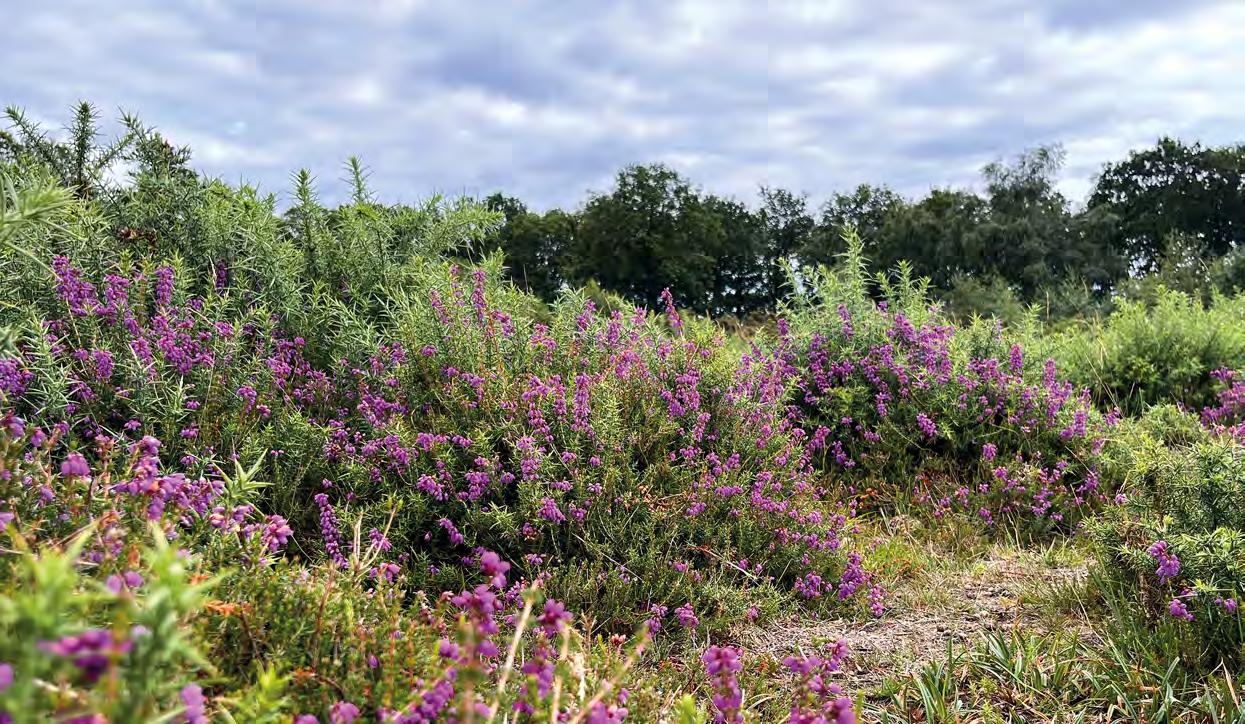
Tiptree Heath is a unique site, mainly for the habitat that characterises most of the reserve. As the largest surviving area of heathland in the county, the site has been designated a Site of Special Scientific Interest (SSSI). Found below 300m and characterised by sandy mineral soils with low nutrient status, they were once considered a wasteland of little value. Now, lowland heathland is appreciated and protected for its unique wildlife and austere beauty. This rare habitat, not just in Essex, but across the whole world is even rarer than rainforest, scattered across the UK in small areas. Now, only 20% of lowland heathland has survived the last two centuries, making the protection and management of Tiptree Heath even more important.
Heathland requires constant care, therefore, our conservation team and a group of dedicated volunteers, help to maintain this site for wildlife. In the Middle Ages, when people required trees to be felled and shrub was cut
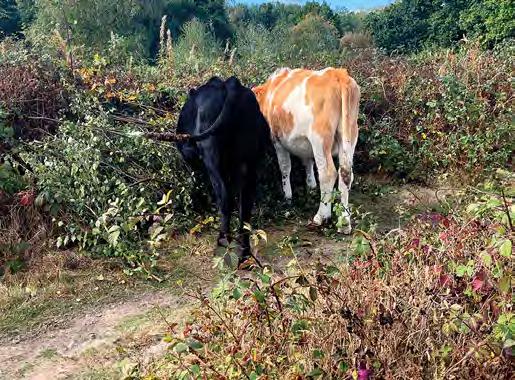
back for domestic use, heathland was created. Presently, the Trust continues to emulate these traditional managing methods and uses hand tools and machinery to keep invasive scrub species at bay and ensure growth is kept to a suitable level. The best management tool, however, is not done by hand. Over centuries, the land has been grazed by cows, sheep and ponies, which help to sustainably manage the reserve. If visiting the site between March and October, keep an eye out for four-legged grazers munching on the heathland. By trampling undergrowth, these animals keep scrub at bay, which would threaten heathland flowers and heather.
There are many guided walks and talks hosted at Tiptree Heath on a variety of wildlife topics including moths, bats, grasshoppers, heather, birds, bees, butterflies and fungi. To find out what upcoming events you can attend, visit the Trust’s event page: www.essexwt.org.uk/events

Heather in bloom
Most heathlands are recognisable from the plants that grow upon them: heathers, gorse and grasses. At Tiptree Heath nature reserve, heather and bent grass dominate the landscape. Best in the late summer, but continuing into the autumn, bell-shaped flowers of pink and purple burst from long-stemmed shrubs, attracting pollinators like bees and butterflies to their colourful displays.
As the only site in the county to boast all three types of heather, Tiptree Heath is a special reserve. It is unusual for the three to grow together, as they each prefer different soil types, but the geology of the site allows for the different species to prosper together here. Underlying London clay in some areas contrasts with well-drained sandy gravelled soil in others.
Here’s how to distinguish them:
The most common of the three species, look for pale purple flowers arranged in spikes growing along the stems.



Usually the earliest heather to bloom in summertime, they boast darker purple, bell-shaped flowers and are larger than the ling flowers. It also has tiny, narrow, dark green needle-like leaves. Prefers drier conditions than the other species.
Cross-leaved heather
Also known as bog heather because it prefers damper areas and wet heaths. It gets its name from the distinctive whorls of four leaves that occur along its stem.
Although renowned for its abundance of heather, Tiptree Heath boasts wonderful wildlife all year round. Other colourful plant varieties that burst into life include gorse and bird cherry, with its delicate white flowers protruding in spring. Aside from heathland, a stream and woodland surround the reserve, with oak, birch and aspen trees towering overhead.


The heathland is home to a range of small mammals, including mice, voles and shrews. The rare and endangered dormouse is also supported at this safe haven. These can be essential food sources for hungry birds, like tawny and barn owls. The mixture of habitats that exist here makes it a fantastic site for birdwatchers. Sightings include the beautiful-sounding songbird, the nightingale, alongside linnets, great spotted and green woodpeckers, willow warblers, chiffchaffs, cuckoos and whitethroats. Throughout the year, birds of prey often visit, including buzzards, sparrowhawks and red kites.
If you are an insect lover, this is a great site to spot interesting invertebrates. Grasshoppers, dragonflies, spiders and moths all call Tiptree Heath home. Notably, wasp spiders are strikingly striped with yellow and black markings, and create a web low to the ground, ready to catch a sprightly grasshopper springing along. Fluttering amongst the heather, heath speedwell, heath milkwort and other heathland flowers, hundreds of butterflies can be identified, from ringlets to gatekeepers. Don’t forget to look closely at your feet, as you may spot the tiny holes made by the small but mighty minotaur beetles along the pathways.
‘With a network of kissing gates connecting dozens of pathways, every visit to this reserve can be different from the last.'Ling heather: Amy Lewis, bell heather: Chris Lawrence, cross heath heather: Ross Hoddinott/2020VISION
Did you know that 40% of the world’s birds are migratory? This means we get a chance to spot exotic, rare and elusive species, paying us a visit in Essex. Some birds travel short distances to migrate for breeding, feeding or resting purposes. Others make epic journeys, thousands of miles across oceans, to survive and reproduce each year. Find out what migratory birds you can spot in Essex throughout the year.
The UK’s smallest tern and one of the rarest breeding seabirds. Migrating from West Africa to the Essex coastline to breed in the spring, this journey is a long one for a bird weighing the same as a tennis ball. However, the little tern is one of the UK’s most vulnerable bird species, with numbers declining since the 1980s.
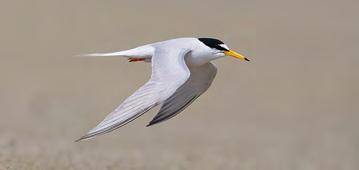
Where to spot
Colne Point nature reserve
When to spot April - August

Across Essex, our reserves can be hotspots for migratory species. As the summer ends, we say goodbye to our visitors like swifts and swallows, but we welcome a new hoard of seasonal wildlife. Find a reserve near you: www.essexwt.org.uk/nature-reserves

When it comes to migratory birds, many birdwatchers will travel to see spotted flycatchers in the summer. These beautiful passerines will return to the same general perching location, having darted out to catch a small flying insect. At the end of August, they will return to their tropical breeding grounds in west Africa.
Where to spot
When to spot May - September
When they arrive at the end of the summer, their stunning seasonal breeding plumage is still on display and will be retained for a short while. As autumn sets in, their winter plumage of greys and snowy-whites will emerge. Sanderling numbers in the Thames Estuary can be sizeable with a recent high count of 850 at Gunners Park.
Where to spot
Gunners Park and Shoebury Ranges nature reserve
When to spot September - May
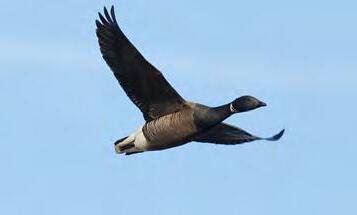
These are one of the furthest travelling and most northerly breeding species of geese, travelling from their Arctic breeding grounds to the Essex coastline. Essex is home to around 5% of the world’s population of dark-bellied brent geese. They rely on the saltmarsh and estuary habitats of the Thames, Crouch and Blackwater for replenishing energy levels over the winter.
Blue House Farm nature reserve
When to spot October - April

One of the nation’s favourite songbirds, the nightingale has declined by over 90% in the last 50 years. But luckily, Essex is a stronghold for these melodic birds and we enjoy listening to their loud songs from late spring onwards. It’s only the male birds, however, that use their glorious singing voice – they sing to attract their mate.
Fingringhoe Wick
Nature Discovery Park
When to spot April – July
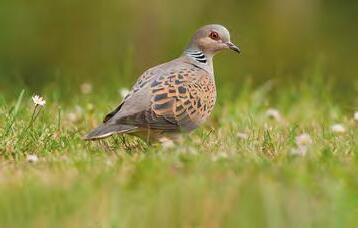
The purring of a turtle dove is a must-listen for most nature lovers. At Wrabness nature reserve, the Trust and volunteers manage the site to maintain and restore turtle dove habitat. As Britain’s only migratory pigeon or dove, look for mottled chestnut and black wings and a black tail.
Where to spot Wrabness nature reserve
When to spot April – September
Reintroduction is a hot topic in conservation. It’s essentially bringing a species back to an area from which it has been lost. In my opinion, reintroduction should be a last resort. We should be working hard to hold on to what we’ve got without letting it get to that stage. We should have a government doing an awful lot more to stop wildlife from being lost, and to help threatened species recover.

But our wildlife is in a sorry state. It’s been said many times that we are one of the most nature depleted countries in the world – when I look around now and think about what we’ve lost since I was a young lad walking the fields of mid Wales, I can believe it. Curlews, lapwings, yellowhammers, linnets; pools full of frogs, toads, and newts – so many have now disappeared. It’s not too late to save these species, but for others, last resorts are all we have left.
Where species have gone extinct from an area because of human activity, I think reintroducing them is very much justified. Especially so when species have a hugely positive impact on the environment, bringing benefits for a whole host of other plants and animals. Take beavers, for example. They create and maintain incredible wetland habitats, providing ideal conditions for many species, from water plants to amphibians to fish. This habitat creation is more important than ever as hot, dry summers become more frequent.
Thanks to reintroductions, there are now wild beavers back in Scotland, with a few in England too. But Wales is lagging behind. Beavers are back in Wales, but legally only
in enclosures. I was privileged enough to be there when they arrived. It was an amazing feeling to be a small part of this event, but imagine how much better it would be to see them in the wild.
I’ve been quite shocked at the opposition to reintroducing beavers. I think a lot of it comes from a lack of understanding of beaver behaviour, and how many benefits they bring. Yes, there may be one or two areas of conflict, but there are plenty of measures to mitigate this. It’s already been done successfully in countries across Europe, where people now live happily alongside beavers. Any mention of reintroducing lynx raises even more opposition in some places, but I also think there’s a place for lynx in the UK. We have big problems with overgrazing as a result of high deer populations, and lynx could help with that. I’d be very interested to see them return and what effect they would have.
I’m obviously concerned about wildlife across the whole of the UK, but as a Welshman what I would really love to see is the reintroduction of both beavers and golden eagles to Wales. We had an escaped golden eagle set up home here for over 10 years and it had a fantastic reception from the local community, including farmers. Some were overawed by the beauty and the sheer size of her. It would be fantastic to see golden eagles back in Wales for good.

Find out all about Wildlife Trust reintroduction projects:
wildlifetrusts.org/reintroductions

The Wildlife Trusts have been invovled in many successful reintroduction projects across the UK, including the return of beavers. We’ve also helped bring back water voles, pine martens, dragonflies, and butterflies to parts of the UK from which they’ve been lost.
Iolo Williams is a Welsh ornithologist, conservationist, and popular wildlife presenter, known for programmes including BBC’s Springwatch and Wild Wales. He has been supportive of the Wildlife Trusts for a long time and in 2021 took on the role of vice president of The Wildlife Trusts.



Find out what makes wildflower meadows special and how the Trust is working in different ways to restore them across Essex.

You may have heard of this habitat, but what is a wildflower meadow? In simple terms, wildflower meadows are areas of permanent grass where wildflowers grow. Surprisingly, wildflower meadows grow best on soil which isn’t very fertile. This is because on fertile and rich soil, grasses and quick-growing flowers can outcompete some of our rarer species that need room and time to grow.
Wildflower meadows are vital for pollinators. On a single day in summer, half a hectare of wildflower meadow can contain 3 million flowers, providing pollen and nectar for thousands of pollinators. Characteristic species of wildflower meadows include yellow rattle, cornflower, red clover, oxeye daisy, cuckoo flower, bird’s-foot trefoil, and many species of orchid.
However, wildflower meadows have faced pressures from farming and urban developments, leading to a 97% decline in this habitat since the 1930s. With only 3% left of our wildflower meadows, it is more important than ever to do what we can to restore them.
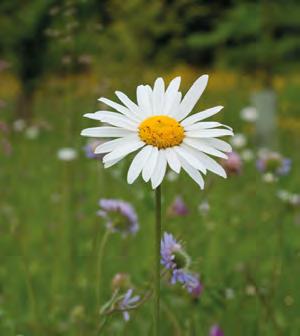
The Coronation Meadows project is celebrating its 10-year anniversary this year. A recent audit conducted by Plantlife and The Wildlife Trusts reveals the success of the King’s vision, a decade after its conception.


In 2013, the former Prince of Wales launched the Coronation Meadows, to honour the 60th year of our late Queen’s accession to the throne and her coronation. The Wildlife Trusts and Plantlife worked together to identify 60 species-rich meadows across the country, known as Coronation Meadows – one for every year of the Queen’s reign at the time. Supported by Biffa Award, these special places became donors to provide precious seed to increase the amount of valuable and beautiful wildflower habitat that exists in the country.
The project resulted in 101 wildflower meadows being created and restored. The charities recently highlighted the success of the project not just for wildflower species but for wildlife that relies on this habitat, from bees to butterflies and bats to birds.
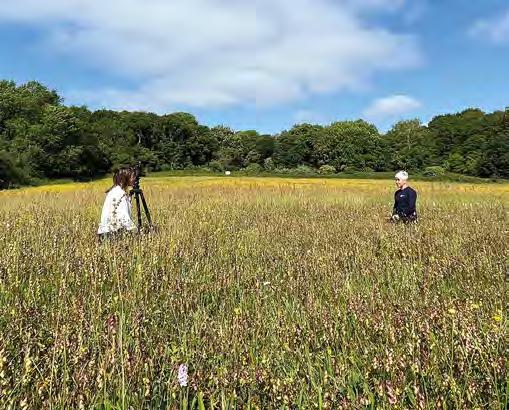
As the biggest inland reserve for Essex Wildlife Trust, this is a site with many fantastic habitats. Rough Piece meadow, 3.5 hectares in size, was deemed one of the country’s most biodiverse meadows and selected to be the donor site for a new Coronation Meadow in 2013. Each spring thousands of green-winged orchids bring colour to the meadow and as the season progresses these are followed by common spotted orchid and a handful of southern marsh orchids too. Other important species are yellow rattle, ragged robin, oxeye daisy, common knapweed and red clover. The abundance of wildflowers is important for pollinators, including a range of bees and marbled white, small copper and peacock butterflies.
One of these newly-created meadows is situated in the most unlikely of places. Thanks to donations from Langdon’s biodiverse meadow, a wildflower meadow sits atop a retired landfill site in the south of Essex. After 10 years of the project, the wildflower meadow is teeming with life. Not only does it support rare insects such as shrill carder bees, Essex skipper butterflies, hummingbird hawk-moths and many more, it has become a skylark nesting site. In summer, skylarks will sing loudly above the meadow, raising their young and eating seeds, grains or an appetising insect. Thanks to the diversity of its donor site, orchids now bloom here throughout the season too.
We celebrated our Coronation Meadows on Sky New’s Climate Show with Tom Heap recently. Scan the QR code to watch.
‘ Since the 1930s, we have lost 97% of wildflower meadows in the UK. ’Oxeye daisy: Gemma de Gouveia Southern marsh orchid: Kieron Huston Common blue
Chafford Gorges Nature Discovery Park is the Trust’s most biodiverse site, known for its array of habitats, rich geology and history. As a Site of Special Scientific Interest (SSSI), it supports many important habitats. As one of the last remaining reserves in Essex to support chalk grassland, the site sees many rare and nationally-important species of wildflower and insect, including man orchids. By clearing an area of secondary woodland, the glades can be expanded into meadows, moving more of the chalk grassland from ‘unfavourable’ to ‘good’ condition. These grasslands will help to extend the range of species relying on the rare habitat, such as great crested newts, butterflies, moths, alongside an array of wildflowers.
A similar project was completed successfully elsewhere on the site in smaller sections which is why Natural England are supporting us to complete this larger scale recovery project.
This project will commence in September, with initial work lasting for around six weeks. A secondary phase will begin in the spring of 2024. During the work, paths may be temporarily closed to keep everyone safe. Please take note of closures and diversions at the site.
out for:
Restoring our wildflower habitats doesn’t just stop at our nature reserves. The Trust runs a series of wildflower-focused campaigns to help restore, conserve and educate about the wildflower populations we have in Essex.
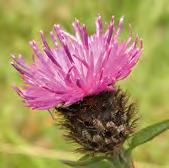



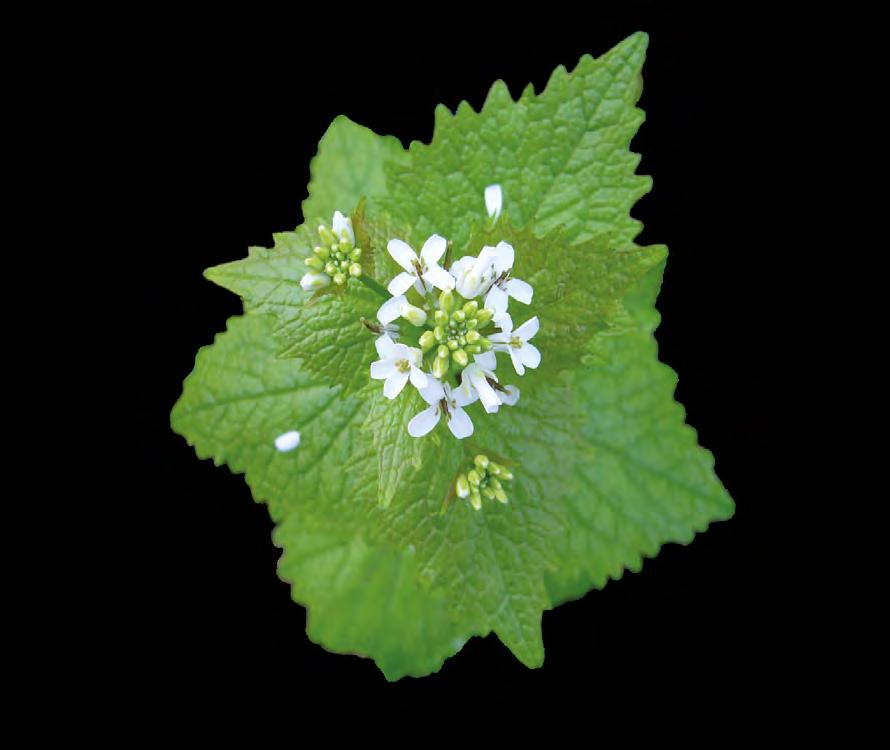
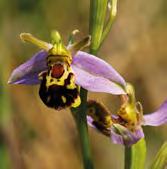
Have you noticed any of your favourite flowers blooming earlier or later than expected? Last year the Trust began a 10-year partnership project with the University of Essex to find out why. More specifically, to determine how much the changing climate is altering trends.
The Essex BioBlitz was the first study of its kind in our county. We asked everyone to download the free iNaturalist app on their phone and take photos of wildflowers anywhere in Essex. From April – September, over 1,200 people recorded a staggering 17,994 wildflowers. We saw 975 wildflower species identified including the more commonly spotted red campion, creeping thistle and garlic mustard to the less commonly spotted giant goldenrod, black-bindweed and sun spurge. For many, The Essex BioBlitz became more than just a research project. Many participants reported that taking part in the project helped them to learn more about local flora and improved their mental health.

Since the project started over 45,000 wildflowers have been recordedGarlic mustard: Lizzie Wilberforce Kidney vetch: Vaughn Matthews, marjoram: Rachel Scopes, common knapweed: Philip Precey, bee orchid: Amy Lewis. Wildflowers recorded as part of The Essex BioBlitz
So we can identify long-term trends and compare data year on year, we requested your help once again this year. Since 1 April, over 850 people in Essex have recorded over 32,000 wildflowers. Thank you to everyone who has taken part so far this year. Over 1,300 species have been spotted from cuckooflower to cursed crowfoot.
But it’s not over yet, we need as much data as possible so we can protect the nature on our doorstep. Please continue to submit records until 30 September to contribute to this vital climate change research.
Follow these simple steps to take part:
1. Download the free iNaturalist app, available on iOS and Android, and join The Essex Bioblitz 2023 project.

2. Take as many photos of wildflowers as you can anywhere in Essex - you don’t need to be an expert at identifying wildflowers as the app does the hard work for you.
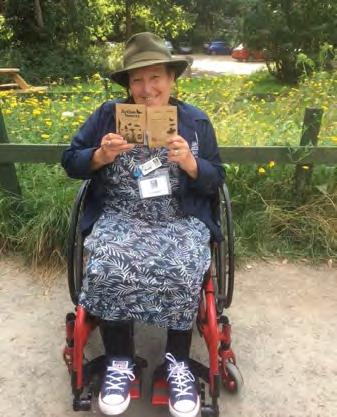
3. Keep going! Anyone who submits over 30 wildflowers will be in with a chance of winning one of our voucher prizes.
Learn more about The Essex BioBlitz by scanning the QR code or by visiting: www.essexwt.org.uk/essex-bioblitz
Did you know that 41% of insect species are threatened with extinction? This is largely due to significant habitat loss. The Big Wild Seed Sow combats this by giving out thousands of free packets of wildflower seed to people in Essex each year. Since 2021, the project has created approximately 26,000 square metres of new wildflower habitat. Over the last two years, we’ve enjoyed seeing gardens transformed for wildlife, bursting with fragrant and colourful native wildflowers.

But most of all, it’s incredible to see the new wildflower corridors stretching out across the county thanks to participants who have mapped their wildflower patches on our virtual map.


This autumn, the third year of The Big Wild Seed Sow is in full swing and we’re hoping to extend the already thriving wildflower corridors by a further 14,000 square metres. You can take part by visiting your nearest Nature Discovery Centre and collecting your free packet of wildflower seeds. Every packet planted will help insects fly, jumpand flutter further across the county.
Participants plot their wildflower patch on our virtual map at www.essexwt.org.uk/ big-wild-seed-sow
“Taking part in The Essex BioBlitz makes learning about wildflowers easy! To be honest, it’s almost become addictive, and I’ve learned so much along the way.”
Sue, 2022 participantThe Big Wild Seed Sow has given over 12,000 people the chance to take action for insects for free.
Did you know that toads migrate? Usually after a spell of damp, mild spring weather, often around Valentine’s Day, thousands of toads journey back to their ancestral pond to reproduce. Some male toads even wait near the pond and piggyback on the females the rest of the way in a mating grip. Over the summer, young and old toads venture away from the pond and the hunt for slugs, spiders and other delicious insects begins. This feast usually takes place in woodlands, gardens, hedgerows and tussocky grasslands. Toads don’t hibernate but they do spend the winter months hunkered down in piles of leaves, under compost heaps or nestled under logs or stones. You might even find them in old flower pots. Some adults will make a return migration to these cosy winter spots. However, they might make a brief reappearance during milder spells to top up on winter snacks.
What do you think of when you hear the word ‘toad’? Perhaps your thoughts jump to their warty backs that excrete a toxin making them an unappealing snack for predators. Or their stealthy crawl that distinguishes them easily from frogs who prefer to jump. Maybe spotting a common toad or toadlet is an early childhood memory of yours and you were told not to touch it for you might become plagued with warts too. Or your mind is flooded with stories of folklore and witches. Whatever preconceptions you have about these seemingly grumpy amphibians, it’s safe to say there is much more to toads than meets the wart.
Toad migrations are quite the spectacle, with thousands of toads following the exact same route each year. If more than 1,000 toads are known to crawl across a road in a particular spot, it is dubbed a ‘toad crossing’ However, with busy roads often blocking their vital migration routes and the destruction of their breeding ponds, toads are declining rapidly. It is estimated that 20 tonnes of unlucky toads are killed on the UK roads every year.
This autumn, you can help. Before the toads knuckle down for winter, we need you to keep an eye out for our warty friends and record sightings of toads and toad crossing through the Toad Watch survey. Once we have enough records to locate key toad crossing in Essex, we plan to work with local councils to install toad crossing signage to inform drivers to be extra careful in those areas.
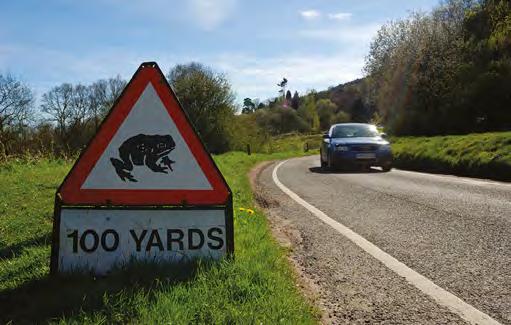


Once the toads are tucked up for their winter rest, the best thing you can do is build a DIY pond in your garden and create a toad shelter nearby to make a haven for your neighbourhood toads. Winter is the perfect time to build even a mini-pond for wildlife as it will establish much quicker and will be ready for, not just frogs and toads, but all varieties of wildlife in the spring. Insects, birds and mammals alike will flock to your garden oasis, to breed, drink and bathe. You can even plot your DIY pond and toad shelters on our Nature Neighbours virtual map and see others taking action for amphibians across the county.
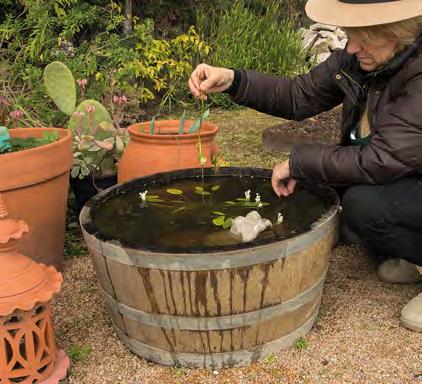


Scan the QR code to download our DIY guides and plot your pond or toad shelter on our Nature Neighbours virtual map.

As autumn draws in, birds seek shelter in our gardens looking for food to keep them going through the harsh winter months. Whilst we embrace the season, often decorating our houses with pumpkins and squash, keep in mind that birds may be struggling to find food at this time. Wildlife that may benefit from pumpkin leftovers are garden birds, who may enjoy the seeds. We’d recommend saving the seeds from your pumpkin, drying them in the oven at 180°C, and putting them in your usual bird feeder.
Use a sharp knife to cut the top off of your squash, be careful when doing this and ask for help if needed.
Scoop out the insides of your squash deep enough to create room for your bird seed.
Push your skewer through one side of your squash, about 1 cm from the top, make sure it goes through both sides.
Cut a length of string long enough to hang your squash up, poke the string ends through both sides of your squash and tie firmly.
It’s time to fill your bird feeder up! Pour the bird feed into your squash.
If you make your own squash bird feeder, we’d love to see it, send your pictures to magazine@essexwt.org.uk
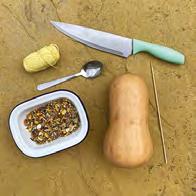

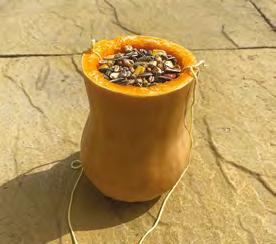



Hang your bird feeder up in your garden and watch the birds swoop down to feed throughout the chilly winter months.
Compost your creation after the garden birds have feasted on it for approximately one week. Make sure to hang your feeder high off the ground so that your pumpkin or butternut squash is only a tasty snack for your feathered friends.
 • Butternut squash or pumpkin • Sharp knife
• Skewer • Spoon • String • Bird seed
• Butternut squash or pumpkin • Sharp knife
• Skewer • Spoon • String • Bird seed








Peter and Eileen had an enduring mutual appreciation of the natural world in the 43 years they were together.

When Peter passed away in 2021, he kindly left a gift in his Will to Essex Wildlife Trust, so we could continue our work protecting the natural world that had brought him and his partner such joy.

Eileen recently purchased a bird plaque on our commemorative Tree of Life at Fingringhoe Wick Nature Discovery Park in memory of Peter. Whilst speaking with Eileen, I asked what had motivated Peter to leave a gift in his Will as I’m always fascinated by such kind-hearted generosity.
She recounted that their relationship blossomed as she shared her love of wildlife with Peter. In Eileen’s words, Peter soon became hooked and was ‘quite the botanist’, taking time to research the habitats and behaviours of flora and fauna. He loved watching the birds and she recalls how he managed to spot all three types of diver (red throated, black throated and great northern) on the Blackwater.
They enjoyed trips to Tollesbury, where they spotted many raptors and short-eared owls. As a team, they marvelled at the variety of species at Chafford Gorges and they spent many hours hunting for a rare little plant called crested cow-wheat (melampyrum cristatum) which, after plotting all possible locations on a map of Essex, they eventually found whilst walking along a lane on both sides of the verge.
For Peter, leaving a gift in his Will ensured his love of nature could live on.

In May, we were delighted to bring back our first in memory thank you event since before the pandemic. A guided walk through the bluebells at Belfairs Nature Discovery Centre was a beautiful way to warmly thank our supporters who donated to Essex Wildlife Trust in memory of friends or family.


Site Manager Greg and volunteer Eddie took the group around Belfairs, giving everyone an opportunity to learn about the reserve and the wildlife that calls it home.
These informal, small events are one of the ways we say thank you to the friends and families who have given to Essex Wildlife Trust to remember a loved one, through a gift made in their Will, a memorial, or funeral donations.

We will be holding these events bi-annually; we love to get to know our supporters better and there is nothing greater than being able to say thank you face-to-face! Our wonderful supporters also get to explore somewhere new, see the brilliant work we do and meet like-minded people.
If you’d like more information on funeral donations, our commemorative Tree of Life, memorials or gifts in Wills, then please don’t hesitate to get in touch.


You can call our Legacy team on 01621 735233, email legacies@essexwt.org.uk, visit www.essexwt.org.uk/celebrate-commemorate or scan the QR code to find out more about leaving a gift in your Will.

We can’t thank those who leave a gift in memory of a loved one enough.Lizzy Steward, Legacy Officer Becky Jedrzejewski, Individual Giving Assistant
It’s time to wrap up and get outside. See the wonderful autumnal colours as the trees change from green to ochre yellow and burnt orange to deep red. Take shelter from the elements at our Nature Discovery Centres and get cosy with a hot chocolate. We have lots of events you can get involved in and we can’t wait to welcome you through the doors to show you the wonders of autumn around Essex.
Abberton Reservoir Nature Discovery Park
Church Road, Layer-de-la-Haye, Colchester, CO2 0EU 01206 738172 / abberton@essexwt.org.uk
Large flocks of fieldfares and redwings will appear over the autumn months attracted by the variety of berries on site. Snipe, spotted redshank, pintail, godwits and golden plover will become more prominent; and for those hardy visitors the odd scaup may be spotted in amongst the many tufted ducks.
Jo Wray, Site ManagerEastwood Road North, Leigh-on-Sea, SS9 4LR 01702 477467 / belfairs@essexwt.org.uk
September 2023 sees our 10th anniversary and as we enter autumn it’s a great time to reflect on how far we’ve come. With over 250,000 visitors a year we can truly say we sit at the heart of the local community advocating for wildlife. Roll on the next 10!
Greg Borgartz, Site ManagerHawkswood Road, Downham, Billericay, CM11 1WT 01268 711001 / hanningfield@essexwt.org.uk
At this time of year, there is the opportunity to enjoy the spectacular autumn colours in our woodlands, and to observe the ever-changing birdlife on the reservoir. With our departing summer migrants, we welcome our arriving winter species.
Michelle Rayner, Assistant Centre ManagerBedfords Park Nature Discovery Centre
Broxhill Road, Havering-atte-Bower, RM4 1QH 01708 748646 / bedfords@essexwt.org.uk
Over the last few months our amazing gardening volunteer team at Bedfords Park have worked extremely hard to restore our water feature in the front gardens. It hadn’t been operational since the Covid pandemic. We welcome all visitors this autumn and encourage you to have a look at the fantastic developments being made.
 Ben Stokes, Site Manager
Ben Stokes, Site Manager
South Green Road, Fingringhoe, Colchester, CO5 7DN 01206 729678 / fingringhoe@essexwt.org.uk
Autumn is all about our returning wintering waders and getting cosy in the centre. Take a stroll to see the flocks of returning waders feeding on the estuary or join our new adult drop-in knit and natter group on a Saturday once a month. Come along to learn, or simply knit in company.
Verity Hales, Site ManagerHornchurch Country Park, Squadrons Approach, RM12 6TS 01708 520364 / ingrebourne@essexwt.org.uk

There is plenty to do now summer has drawn to a close. Take a walk through the Ingrebourne Valley and pick up a pocket guide to mushrooms - don’t pick but just observe all the wonderful species that are popping up. You can get creative as well and use the fallen golden crunchy leaves to create a nature-themed collage.
Kate Tyler, Assistant Centre ManagerLangdon
Lower Dunton Road, Basildon, SS16 6EJ 01268 419103 / langdon@essexwt.org.uk
We’ve had a busy summer, celebrating our two-year anniversary in July, taking part in National Marine Week activities and enjoying a packed calendar of summer holiday activities. But with the changing season, there’s still plenty to see and do at Langdon. Come and visit to enjoy miles of beautiful woodland, meadows and lakes.
Charlotte Goodman, Site ManagerMucking Wharf Road, Stanford-le-Hope, SS17 0RN 01375 643342 / ttnp@essexwt.org.uk
There’s no such thing as a quiet time at Thameside, even after the busy summer holidays. It will soon be time to take the conservation hay crop from our wildflower meadow and bring in our grazing herd. Come and see the popular cattle as they help us manage our grassland through the winter and create ideal conditions for our nesting skylarks.
 Jimmy Allan, Site Manager
Jimmy Allan, Site Manager

Old Hall Lane, Walton-on-the-Naze, CO14 8LE 01255 679379 / naze@essexwt.org.uk
As the summer fades away, join us on our walking tours searching for dark-bellied brent geese and other wintering waders. There are geology and history tours for visitors looking to explore our wonderful coastline. We will also be starting beginner art classes with a ‘Nature in Watercolours’ theme for budding creatives.
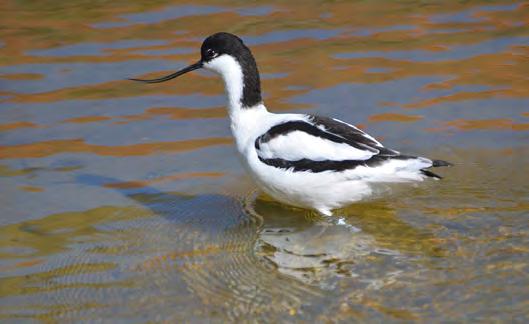 Helen Daw, Assistant Centre Manager/Visual Merchandiser
Helen Daw, Assistant Centre Manager/Visual Merchandiser
Thorndon Park North, Brentwood, CM13 3RZ 01277 232944 / thorndon@essexwt.org.uk
As the summer fades and we begin the new season of autumn, why not pop into our new sensory garden for some mindfulness and to reflect on the change around us? You can also enjoy a walk around the Gruffalo trail and then pop into the café to warm up with a coffee.
 Paula Billinge, Assistant Centre Manager
Paula Billinge, Assistant Centre Manager
Just like that, not-so-fluffy fledglings have flown the nest, tiny tadpoles have transformed into toads and sleepy seals have soaked up all the summer sun. Autumn is finally here and even though it might seem like nature is winding down,


In the air, massive starling murmurations fill the skies encouraging wide eyes and open mouths from all who bear witness. Wavering lines of dark-bellied brent geese fly overhead searching for a winter spot to rest and feed. On the ground, fiery auburn leaves crunch underfoot making it almost impossible to tiptoe between the trees unnoticed. Bright red fly agaric mushrooms push up from the undergrowth, making many wonder if stories of fairies and magical creatures might just harbor a sliver of truth. For how could a season so enchanting come to exist without a little magic?
For some, autumn is a busy time spent feasting on bugs and berries and foraging for bedding as they prepare for a long winter nap. Hedgehogs prefer cosy spots under sheds, in thick undergrowth or in big piles of leaves. Tiny hazel dormice build ground-level nests only big enough for them to squeeze into. Bats prefer to see the winter through from high up in hollow trees or old barns. Though these are the only mammals that truly hibernate, some butterflies, ladybirds, solitary bees and wasps hibernate too!
Discover things to do and spot in September, October and November
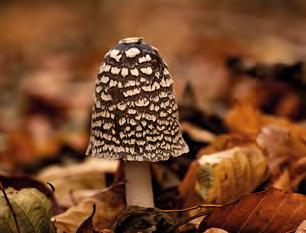

We’ve created a handy checklist to cut out and keep, featuring some of autumn’s most iconic wildlife. So get ready to traipse through the trees, meander across meadows and gaze across the garden to spot as many as you can.




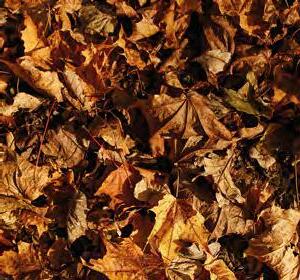
Spotted some of these? We'd love to see. Tag us in your photos and videos on social media or send us a picture of your finds to magazine@essexwt.org.uk
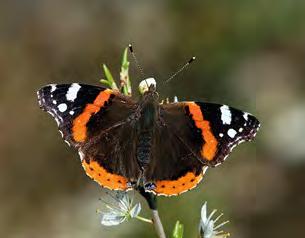





• Sunday 17 September and Sunday 10 December
• 10.30am-12pm
• Fingringhoe Wick Nature Discovery Park, CO5 7DN
Join us for a seasonal Ranger-led walk round the reserve. Stop to enjoy the seasonal highlights, ask questions and relax in nature. £4 per person and £8 per family.
• Sunday 24 September
• 10.30am mass start
• Belfairs Woodland Centre, SS9 4LR
Join us for a 5(ish!) mile run, which takes you through ancient, coppiced woodland, home to rare butterflies, song thrushes and wildflowers. £10 per person.
Guided Walk
• Saturday 14 October
• 11am-1pm
• The Naze Nature Discovery Centre, CO14 8LE
Guided tour of The Naze with an emphasis on its fascinating history. £7 per adult and £2 per child, book online.

• Tuesday 17 October
• 7.15pm-9pm
• St Andrews Church Hall, CO9 2LD
A talk by Jon Cranfield covering both species of snake in Essex with the main focus on the adder, and efforts to conserve them.

Photography Workshop: ‘Know the Basics’


• Saturday 18 November
• 10am-4pm
• Hanningfield Reservoir Nature Discovery Park, Billericay, CM11 1WT

Daniel Bridge is running a one-day workshop designed to help you get the most from your camera. £70 per person, book online.
• Sunday 29 October
• 10am-2.30pm
• Sandylay and Moat Woods Nature Reserve, CM3 1PS
Colourful, beautiful, diverse, the curious kingdom of fungi is right on your doorstep. Come along to our event to learn more. £2 per adult, book online.

Cockaynes Wood Nature Reserve Walk
• Sunday 19 November
• 2pm-4pm
• Cockaynes Wood, CO7 9JX
A beautiful mosaic habitat, Cockaynes Wood is a hidden gem of a reserve and the Volunteer Warden Roger Robson, will lead a walk to find out more about the array of amazing wildlife in the area.
With the changing autumn colours, cooler crisper days and nights drawing in, it can feel harder to get out and about this autumn. But we have a packed calendar with activities to help inspire you to get outside and feel closer to nature. Join Essex Wildlife Trust on guided tours, expert talks and creative workshops all around the county.

Our regular events for children and families:
Nature Tots
Join our weekly parent and toddler group where young children can explore, play and learn through nature, suitable for ages 18 months to five years.
Home Education
Our Forest School home education sessions are a series of specialised, play-based, learning activities.
SEND Forest Fun
Our regular forest outdoor learning sessions for SEND children, where they can learn bushcraft skills, enjoy making natural arts and crafts and go for a nature walk.
Throughout the school holidays, we are offering a wide range of wildlife-themed events, from family activities to drop-off days, at each of our Nature Discovery Centres.
Birthday parties
Are you looking for an exciting and hassle-free party with a difference? Our Nature Discovery Centres offer wildlifethemed birthday parties for all ages.



When you leave a gift in your Will to Essex Wildlife Trust, you’ll be ensuring your love of nature lives on for future generations.
This Remember a Charity Week (11-17 September) we are launching our free gifts in Wills service to make it easier for you to write or update your Will, for free.
Our new service, through Will writing experts Guardian Angel, makes this a quick and easy process to complete. You can do this:
• Online in 15 to 20 minutes at gawill.uk/essexwt
• Over the phone with a solicitor on 0800 773 4014
• Face to face with a solicitor by booking an appointment over the phone
We know the level of thought that goes into making a Will and we are immensely grateful to anyone who commits to supporting us. Any gift – whatever the size – will enable us to continue our work restoring nature across our beautiful county and inspiring action for wildlife.

Abbotts Hall Farm was purchased thanks to a legacy from Joan Elliot. A kind gift from a long-serving member of the Trust enabled us to purchase a new pond-dipping platform at Abberton, helping us to engage children with wildlife.
For more details on leaving a gift in your Will, call our Legacy team on 01621 735233, visit www.essexwt.org.uk/gifts-in-wills or scan the QR code.
Thanks to a gift left in a Will, we installed a new, modern bird hide at Two Tree Island, featuring a grass roof and insect habitats.
Our recent project at Blue House Farm to increase the wetland habitat for wading birds and migratory species was supported by several gifts in Wills.
Delicate, vibrant, enchanting: these might not be words you normally associate with slugs, but sea slugs have no respect for normal. There are several groups that you may come across on UK shores and even the most familiar looking of these, the sea hares, are quirky. These plump brown slugs have tall ear-like rhinophores (scent-sensitive tentacles) and a hidden shell. They lay a tangle of eggs that resemble pink spaghetti and produce a ‘smoke-screen’ of violet ink if disturbed. The solar powered sea slug, on the other hand, belongs to the sap-suckers group. It eats seaweed, retaining the photosynthesising parts – the chloroplasts – in its body, where they supplement the slug’s diet with sugars, like a built-in snack bar.
The largest group of sea slugs, the nudibranchs, are the strangest and most visually stunning of all. With dozens of species to be found in our rock pools and shallow seas, they have become my delight and obsession.



Heather Buttivant is a Cornwall Wildlife Trust volunteer, proud ‘nudi’ fanatic and author of the award-winning blog, cornishrockpools.com
She has published two books: Rock Pool and Beach Explorer.

Sea slugs add a spectacular splash of colour to our rockpools.
Nudibranchs, or ‘nudis’, as they are affectionately known by their ever-growing fan club, are shell-less sea slugs. Their name comes from the Latin, nudus branchia, meaning ‘naked gill’. Nudibranchs are a flamboyant bunch, so they turn their gills into stylish accessories.


One of our most common rocky shore nudibranchs, the sea lemon (Doris pseudoargus), is a case in point. When underwater, this bumpy yellow animal unfurls a glamorous, feathery circle of honey-yellow gills on its back. Other nudibranchs, like the bright purple Edmundsella pedata, have spiky projections called ‘cerata’, providing a large surface area through which they breathe in oxygen.
Tiny Doto spp. slugs win my prize for the craziest body shape. Their white cerata, shaped like towering jelly moulds adorned with cherry-red spots, are so high that they wobble
precariously. Their heads sport two tall rhinophores sheathed in a wide dish, as though they are trying to detect alien radio signals.
Amphorina spp. slugs inflate and deflate their cerata, Facelina spp. have ringed rhinophores like unicorn horns, while Polycera spp. slugs’ heads are fringed with colourful tentacles. Anything goes when you’re a nudibranch.
If you are used to peaceable garden slugs, it can be unsettling to discover that nudibranchs are devout carnivores. While each species has a preferred diet, between them they eat sponges, barnacles, hydroids, anemones, bryozoans, sea squirts and more.
Some nudibranchs change colour. The sea lemon, for instance, turns into a ‘sea orange’ after eating orange sponges. Great grey sea slugs (Aeolidia dive in headfirst to feed among the treacherous stinging tentacles of anemones, their pale grey bodies and cerata often turning bright pink as they eat. Inside their cerata, great grey slugs retain the anemone’s stinging cells, which fire toxic harpoons at any predator that tries to bite them. Other slugs, like Geitodoris planata, have acid glands that burn attackers. Most incredible of all are the Calma
slugs. The vivid blue and yellow Calma glaucoides feeds on clingfish eggs, while its relation, Calma gobioophaga has cerata the shape of goby eggs, allowing it to evade the male goby’s efforts to guard its brood. The fish eggs are so efficiently digested that Calma slugs have no anus and never poo.
For the best chance of finding sea slugs, join an organised event or Shoresearch survey, where experts will be on hand to help you discover more. Look for pale spirals of sea slug spawn on rocks and seaweeds in spring and summer. Sea slugs are

camouflaged. If possible, place your nudibranch in water and watch it magically puff up. Be gentle as sea slugs are delicate. Always put the nudibranch back where it came from, leave everything as you found it and watch the tides.
Finding your first nudibranch is like discovering a sparkling gem. Their exquisite colours and eye-catching shapes make them true treasures of the rock pools.
ore than 100,000 people have signed The Wildlife Trusts’ open letter to the UK Government about HS2, after our latest report into the project highlighted major errors in HS2 Ltd’s calculations – meaning more nature will be lost along the line than was agreed by the Government, and attempts to repair the damage the scheme is causing will be inadequate. The letter urges the Government to oblige HS2 Ltd to accurately recalculate its figures, providing a more realistic picture of the scale of the damage.
Our new report, HS2 double jeopardy, was the result of an almost year-long audit of HS2’s official nature loss calculations. The report revealed a number of errors and causes for concern, including inconsistent mapping and modelling, wild spaces and habitats being undervalued, and huge numbers of trees entirely missing from the calculations.
HS2 Ltd promised that nature would not lose out when much-loved natural areas and important habitats were destroyed to make way for construction of the high-speed rail line. Our report found that HS2 Ltd’s ‘accounting tool’ for
Re-map existing habitats along Phases 1 and 2a, correcting mapping errors, applying the correct nature values to habitats, and ensuring no habitats are excluded.

Immediately pause all construction and enabling works and halt the passage of the Phase 2b Hybrid Bill while these latest audit findings are assessed by the Government.
assessing impacts on nature is untested, out of date and fundamentally flawed.
Construction on HS2 has already caused irreparable damage to precious wildlife sites; it’s vital that HS2 Ltd and the Government listen to our concerns and act accordingly. Now is the time to reflect on the failings of the scheme so far and rethink the next steps, to prevent further excessive damage to our natural world. The Government needs to learn from HS2 to ensure that future ‘green’ infrastructure truly can support nature’s recovery rather than exacerbating its loss. Find out more at wildlifetrusts.org/hs2
Recalculate the total impacts to nature, by using an up to date and proven methodology, such as one directly comparable to the government’s current Biodiversity Metric 3.1. If changes to the methodology are made these should be transparent and evidence based. It is critical that HS2 Ltd ensure all data is made publicly available at the point the figures are released to facilitate transparency and enable independent scrutiny.
Change the scheme’s design and delivery to limit the adverse impacts and enhance biodiversity in a way that is commensurate with the scale of the damage i.e. by achieving a minimum 10% biodiversity net gain for replaceable habitats for each phase of the scheme. Once impacts have first been avoided, limited and compensated for, Biodiversity Net Gain is an approach to leave the natural environment in a measurably better state than it was before the development took place by ‘delivering more for nature than is lost’.
This spring, viewers were captivated by Sir David Attenborough’s latest documentary, Wild Isles. The show celebrated the wildlife of the British Isles, demonstrating to an audience of millions that the UK is home to incredible animals, dramatic battles for survival, and internationally important wild places. Many of the spectacular scenes shown in the documentary were captured on Wildlife Trust nature reserves.
The cameras revealed the incredible lifecycle of the large blue butterfly at Daneway Banks in Gloucestershire, where caterpillars trick ants into accepting them into their nest. At Wiltshire’s Langford Lakes they filmed hobbies hawking for dragonflies,
snatching them from the air with lightning reflexes, whilst at Lackford Lakes in Suffolk they revealed rabbits being hunted by buzzards. Flowers featured strongly as well, from buzzing meadows to the fly-fooling lords-and-ladies, with visits to Avon’s Prior’s Wood and Hutton Woods, Gloucestershire’s Lower Woods, and Wiltshire’s Clattinger Meadows.
Sir David himself travelled to Skomer Island in Pembrokeshire, to marvel at Manx shearwaters and sit amongst the puffins as he reflected on the threats facing our wild isles. The show didn’t shy away from discussing the worrying declines in our wildlife, or the actions that have led to them.

The Scottish Wildlife Trust is part of a coalition of seven environmental organisations fighting to save rare coastal dunes from the construction of a golf course. Proposals to develop Coul Links in East Sutherland threaten irreparable harm to a vital and protected habitat. The proposals come just three years after a previous application was turned down due to the damage it would cause nature. wtru.st/coul-links-proposal
An incredibly rare fungus has been discovered in a survey by Manx Wildlife Trust and the Isle of Man Fungus Group, working with Manx farmers. The butterscotch waxcap, Gliophorus europerplexus, had never been recorded on the island before, with only 70 specimens of the species recorded worldwide.
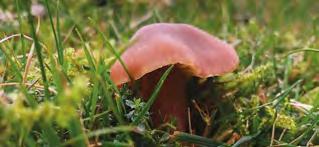
wtru.st/new-waxcap
This year marks the tenth anniversary of Coronation Meadows, a restoration project launched in 2013 to celebrate 60 years since the coronation of Elizabeth II. As part of the project, many Wildlife Trusts provided seeds from their own meadows to create or restore meadows in other parts of their region. Wildlife Trusts
Wildflower meadows are essential habitats for pollinators
also took on custodianship of some of the new meadows, helping wildlife flourish. A new audit has revealed the success of the project, with 101 new wildflower meadows created or restored over the last decade.

Wiltshire Wildlife Trust has launched a new 10-week nature-based-therapy programme for veterans and service leavers living with mental health issues. Wild Transitions will take place at the Trust’s Green Lane Wood nature reserve, providing a space for veterans to connect with nature and learn skills to help them transition into new employment or volunteer roles.
wtru.st/WildTransitions
• Margaret Thatcher was Prime Minister of the UK.
• The internet was invented.
• The UK was hit with red rain – a weather phenomenon caused by winds from the Sahara Desert.
• Michael Jackson’s famous album, Thriller, was released.
...Autumn 1983 when Essex Wildlife Trust was known as Essex Naturalists’ Trust and guest writer Anthony Hoare talks of Essex’s notoriety as a butterfly haven.

Here in Essex, our county is distinguished as the only one to have a butterfly named after it. The Essex skipper was found first in this county in 1888 although at the time it was thought to be an aberration of the small skipper, and the listing of this species as a British species was not published until January 1890.
These are two of the most difficult butterflies to distinguish, and the only really reliable method of identification is to inspect the underside of the antennae. The antennae tips of the small skipper are fulvous/orange; those of the Essex skipper are black. In practice, looking up the nose of a butterfly can be extremely difficult, and these butterflies often remain unseparated in my field notes!
Essex certainly used to be an excellent county for butterflies with a number of species that are now absent. The heath fritillary, now reckoned to be Britain’s most endangered butterfly, used to be found in the county and it is possible that reintroduction will be attempted. The silver-washed and high brown fritillaries also used to be found in Essex and all the other Eastern counties: we have now lost these fine butterflies. Intensive farming and the conversion of land for housing and roads have been the major factors in the decline of butterflies in Essex.
Next time you see a lovely butterfly on a bright sunny day spare a thought for its plight. The world would be a poorer place without these lovely and frivolous insects.
• The £1 coin was introduced.
Ecological evidence is an important part of understanding our species and their abundance. Thanks to our fantastic Conservation Evidence Team, the Trust carries out wildlife surveys across our nature reserves, including butterflies. This year, we asked the public to help us with these records in our new campaign, Butterfly Seekers. We look forward to sharing our results in the next edition of WILD.
Hog’s fennel on Skipper’s Island
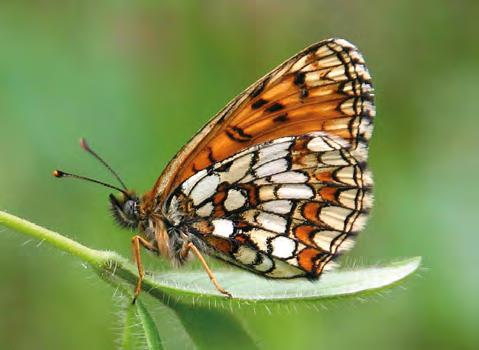
Our pollinators need help. We need millions more wildflowers across Essex to give bees, butterflies and beetles the food and habitat they require to thrive.


You can help bring insects back from the brink by taking part in The Big Wild Seed Sow! From 14 August until 31 October, everyone is invited to pick up a FREE packet of wildflower seeds from one of Essex Wildlife Trust’s Nature Discovery Centres. Sow your native wildflower seeds in your garden, a windowsill planter, a pot or your allotment this autumn and watch next spring as your patch is buzzing with bumblebees and brimming with brimstones.
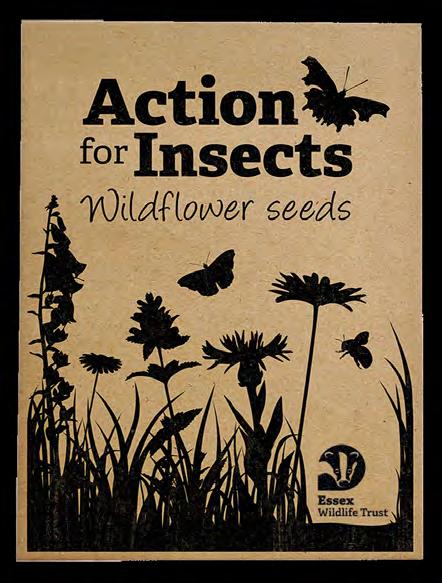
Over the last two years we have seen 22,000 new square metres of wildflower habitat created. This year we are hoping to give out 7,000 more free packets of seeds so that everyone can connect up and create even more colourful and fragrant habitat for insects.


How is your general knowledge on wildlife and the wild places of our country? Test yourself with our nature crossword.
In Britain we have over 270 species of bee! One of the rarest can be found in Essex, the shrill carder bee.
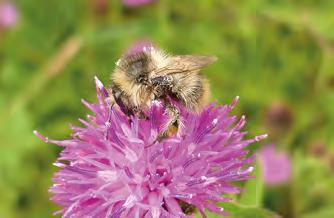
The common lizard incubates its eggs inside its body and ‘gives birth’ to live young, rather than laying eggs.

2 The name for a male duck. (5)
5 Leaves are green because of this chemical. (11)
6 One for sorrow, two for joy…’ is about which animal? (6)
9 The name for organisms that have adapted to the lifestyle of living underground by digging burrows and tunnels. (9)
10 The ____ moon happens around the Autumn Equinox. (7)
11 A family of birds to which the yellowhammer belongs. (7)
1 Species of harrier. (5)
3 The fruit from oak trees, containing a single seed. (5)
4 Resting place for hares. (4)
7 Trees that do not lose their leaves in winter. (9)
8 Autumn used to be called ‘____ of the leaf’ The shortening of this phrase is still used in North America. (4)
9 The ‘Wood Wide Web’ describes the secretive social network between plant roots and mycorrhizal _____? (5)
The answers will be revealed in our Winter 2023 edition of WILD
Ever wondered how the mute swan got its name? Simply, it wasn’t as vocal as other swan species.
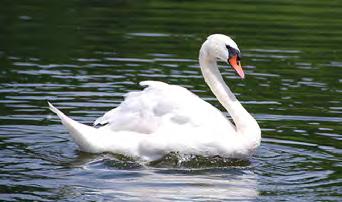
Join
We will hear from some key speakers and give you the opportunity to have your say on the state of nature in Essex, followed by the formal proceedings of the AGM.
This years’ AGM will be held on Zoom, which allows all members to easily join from the comfort of their own home. However, we are looking forward to returning to our Annual Members’ Day celebrations in-person in 2024, to welcome you back to one of our incredible nature reserves.
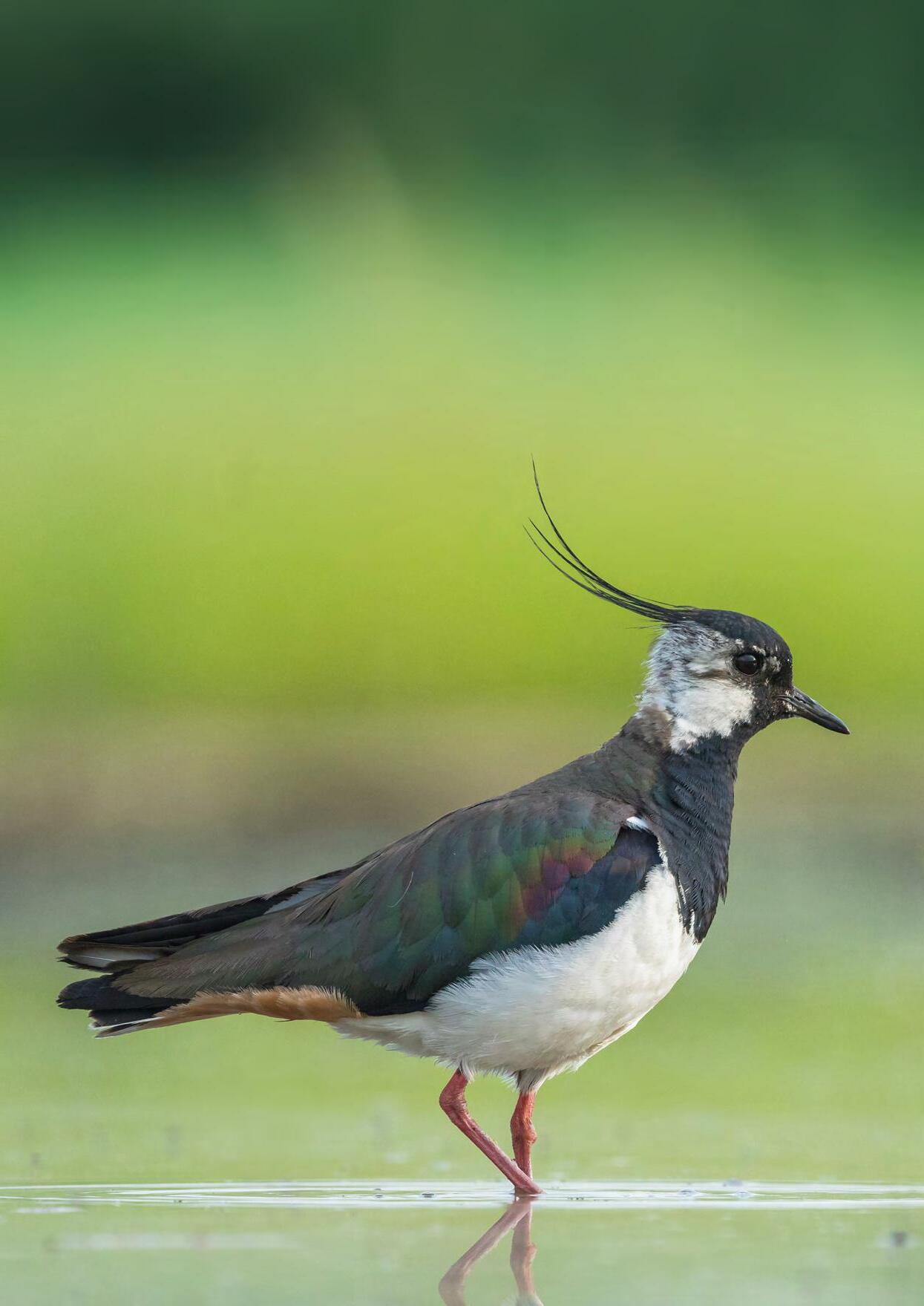
Register online and find out more at www.essexwt.org.uk/agm
Can’t attend? Please complete the proxy form online at www.essexwt.org.uk/agm.

